 |
 |
|
HOW
TO MAKE YOUR OWN LOW-COST
COMIC
BOOK DISPLAY RACK
PUT SOME
NOSTALGIA ON YOUR WALL
|
|
|
|
| |
|
| |
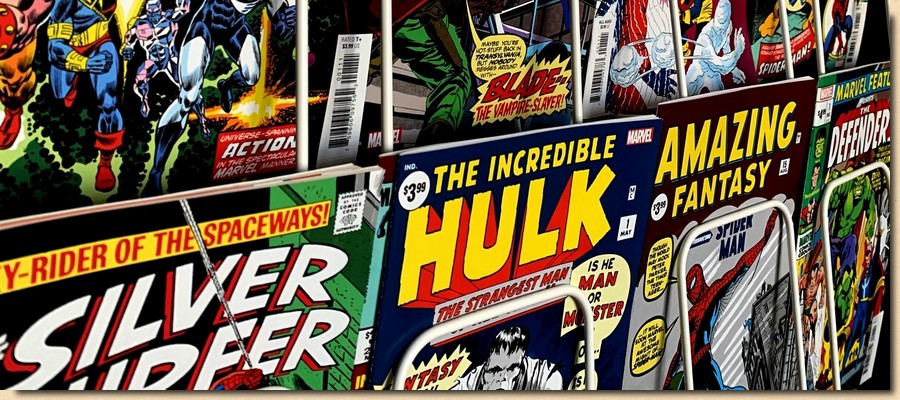 |
| |
| Every hobby has its
nostalgic myths and icons, and for many, few things
embody the youthful days of perusing and buying comic
books the way the spinner rack does. So much so, in fact,
that both Diamond Distributors as well as a Kickstarter
enterprise offered new versions of that swivelling
metal-frame symbol of comic book feelgood in 2019. |
| |
But as is the case
with a good many nostalgic myths, the
spinner rack never was the lighthouse of
comics it is often portrayed as.
"The
cold retailing history was that the
spinner rack was originally developed
not as a showcase, but as a response
to 20th century newsstands and
grocers who found comics unprofitable
and undesirable, and who wanted them
off their magazine
shelves. Sticking them all onto
a standing rack allowed newsstand
owners to stick them off into a
corner - "a place for comics to
go and die," as one observer
recollected." (Miller,
2018)
Of course,
this did not affect the perception of
comic fans at the time, to whom the
spinner rack was where they would
congregate or, if in an unknown location,
look out for.
|
|

A classic spinner
rack, 1956
|
|
|
| |
There was, however, one
serious problem connected to the spinner racks, which was
indeed of concern to comic book fans at the time:
"It
was a constant struggle back then to find a pristine
copy of your favourite heroe's adventures without a
rip or a tear (...) [going] to one store after
another to find (...) even one really good copy of
any given book." (Rosenberg, 2006)
Spinner
racks typcially exposed comic books to potential physical
damage by virtue of how they display them. Potential
customers would often
bend comics to see what was behind them, thus causing
stress lines on the cover that can be quite noticeable, and if they pulled out
a comic book and then decided against buying it, it often
went back into the spinner rack without much care,
resulting in tatty corners and edges and even torn covers
and pages.
|
| |

Toys'R'Us, Orlando
FL, May 2014
|
|
In this age of
condition-conscious collectors, one would
thus expect the spinner rack to be
banished forever as a hellish apparatus
and threat to comic books - but as is
often the case with nostalgic icons,
their perceived status is somewhat
removed from the reality of "back in
the days". The
nimbus of the spinner rack is, however,
somewhat limited to the US - whilst not
entirely unknown to comics fans in Europe
and the UK, they were always more used to
seeing their comic books displayed on
shelves (as is mostly the case in the US
these days).
For obvious reasons,
this method of displaying comic books is
almost as potentially harmful as the
spinner rack.
|
|
|
| |
| However, if
you feel somewhat nostalgic and don't mind some of your
comic books getting a few knocks and wrinkles, but don't want to spend roughly $300 for
a new spinner rack (vintage ones sell for much more),
there is a budget DIY option which gives you something of
a cross-breed between a spinner rack and a display shelf.
|
| |
| All the parts needed
are sold by IKEA, so they should be
available basically anywhere you can find
one of their stores. The main component
for this nostalgic comic book rack is the
Skådis pegboard, which is
available in three different sizes: 36 x
56 cm (14 1/8 x 22"), 56 x 56 cm (22
x 22") and 76 x 56 cm (29 7/8 x
22"). The 36 x 56 cm pegboard will
provide you with a total of six rack
pockets (three rows of two slots).
|
|
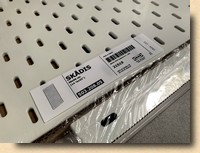
|
|
|
| |
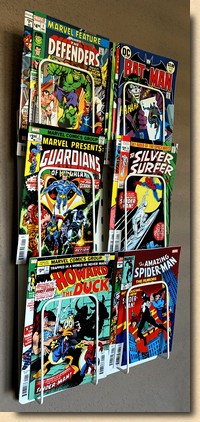
|
|
Mounting the
pegboard to a wall is easy enough. All you need
is a drill, two screw anchor dowels
(depending on what type of wall you're
dealing with) and two screws (these are
not supplied but are needed to secure a
wall mounting rail which comes in the
package).
I got my Skådis
pegboard for 14.95 Swiss francs; it is
currently (November 2019) listed for
£8.00 in the UK and $9.99 in the US.
Along with the pegboard you will need the
galvanized metal, powder-coated Skådis
"letter holders"; they are
available as single items and are
designed to securely slot into the
pegboard. Six of these hooks (article
number 403.208.15) are needed, selling
for 3.00 francs (or £1.50 / $2.00) each.
This puts
the total cost for the rack shown here at
32.95 Swiss francs. In the UK this would
set you back a total of £17.00, whereas
in the US the total bill would amount to
$28.99 - certainly a lot cheaper than
anything you can buy ready-made.
Filled with
some of Marvel and DC's recent facsimile
comics, the visual effect is quite
eye-catching and does evoke a certain
sense of nostalgia.
At this
point, I found that I actually had room
for two 36 x 56 cm pegboards side by
side, so I added another. Of course it
would have been easier (and cheaper) to
simply get the larger pegboard (76 x 56
cm), but then this was initially a test
run of an idea I had when I first saw the
Skådis pegboard in my local IKEA store.
|
|
|
| |
|
| |
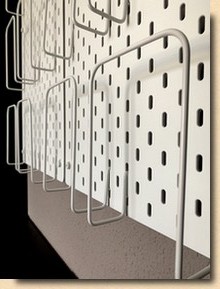
|
|
Be aware and
keep in mind, though, that
displaying your comic books this
way will not keep them in
pristine condition for very long.
Depending on
the number of individual comics
slotted into one bracket holder
(which can hold between five or
six of them, giving this display
rack a maximum capacity of a good
60 issues) there will be
noticeable spine stress and page
rolling, and as the rack is
obviously exposed to light
(although mine avoids direct
sunlight), some discolouration
can also be expected over a
longer period of time.
In other
words: you do not really want to
display your most valuable or
cherished comic books this way.
|
|
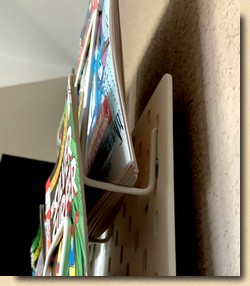
|
|
|
|
| |
| One carefree way around
these worries is to display doubles, i.e. comic books of
which you have two copies. As mentioned, I find the
facsimile editions of classic Marvel and DC titles a
perfect match for this display rack, and as these have
been released very recently (more on these in an upcoming
THOUGHT BALLOON), simply buying two copies each made
it possible to put some great nostalgia on display. Just as back in the days, these
comics are not only meant to look sharp on display, but
are there to be taken down, perused, read, and then put
back again. It's simple and low-budget nostalgia in
motion.
|
